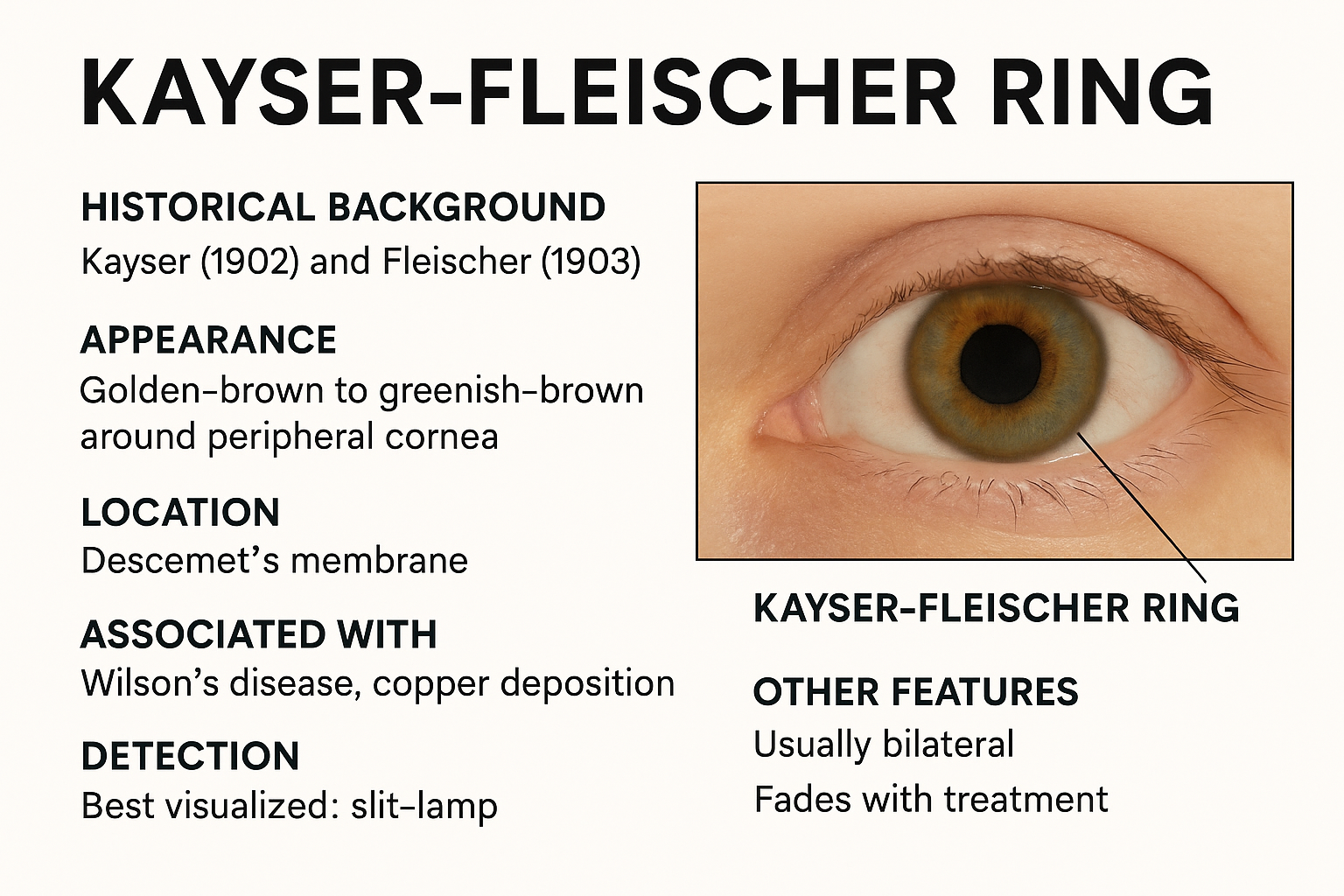Kayser–Fleischer Ring: A Golden Clue to Copper Accumulation
The Kayser–Fleischer (KF) ring is a brownish-green or golden ring seen at the corneal periphery. It results from copper deposition in Descemet’s membrane and is one of the most characteristic features of Wilson’s disease, a genetic disorder of copper metabolism.

1. Historical Background and Eponym
Bernhard Kayser (1869–1954), a German ophthalmologist, first described the phenomenon in 1902 as a “greenish discoloration” of the cornea.
Bruno Fleischer (1874–1965), another German physician, described two more cases in 1903 and correctly identified the ring’s position in Descemet’s membrane.
In 1934, spectroscopic studies confirmed that the ring was composed of copper, not silver as previously thought.
The eponym “Kayser–Fleischer Ring” thus honors both pioneers.
2. Clinical Features
The KF ring appears as a brown, green, or bronze ring around the corneal edge.
It usually starts superiorly and inferiorly (at 12 and 6 o’clock) and gradually becomes a complete ring encircling the cornea.
The ring is typically bilateral and asymptomatic, detected incidentally on slit-lamp examination.
It does not impair vision.
3. Pathophysiology
In Wilson’s disease, defective biliary copper excretion causes copper to accumulate in the liver, brain, and eyes.
Excess circulating copper enters the aqueous humor and deposits in the Descemet’s membrane of the cornea.
The deposition starts in the superior and inferior limbal zones and spreads circumferentially.
The ring reflects systemic copper overload, rather than local ocular pathology.
Despite its distinct appearance, it does not affect vision or corneal transparency.
4. Diagnostic Importance
The KF ring is a major diagnostic feature of Wilson’s disease and supports the diagnosis in patients with:
Chronic liver disease of unclear etiology
Neuropsychiatric symptoms (e.g., tremor, dysarthria, dystonia, behavioral change)
Low serum ceruloplasmin and elevated urinary copper excretion
Detection:
Slit-lamp biomicroscopy is essential; early rings may be subtle.
The ring may fade or disappear with successful copper-chelating therapy, making it a useful marker for treatment response.
Absence of the ring does not exclude Wilson’s disease.
5. Other Conditions (Rare Causes)
Although highly characteristic of Wilson’s disease, similar corneal pigmentation may occur rarely in:
Chronic cholestasis
Primary biliary cholangitis
Prolonged copper exposure (e.g., intraocular foreign body)
These are uncommon and typically lack systemic copper overload features.
6. Associated Ocular and Systemic Findings
Sunflower cataract: a radiating central lens opacity also caused by copper deposition
Hepatic involvement: hepatitis, cirrhosis
Neurological features: tremor, dystonia, parkinsonism
Psychiatric symptoms: depression, personality changes, cognitive decline
The presence of KF rings with neurological or hepatic manifestations is virtually diagnostic of Wilson’s disease.
7. Treatment and Follow-Up
Copper chelation therapy (e.g., penicillamine, trientine) or zinc therapy to reduce copper absorption
Liver transplantation for advanced hepatic failure
Regular slit-lamp examinations to monitor response: the KF ring may fade over months or years
8. Summary Table: Kayser–Fleischer Ring Overview
9. Key Takeaway
The Kayser–Fleischer ring is a small ocular sign with big systemic meaning.
It provides a visible window into copper metabolism disorders—most notably Wilson’s disease—and can guide early diagnosis, monitoring, and treatment success.
Comment